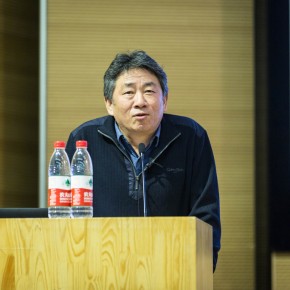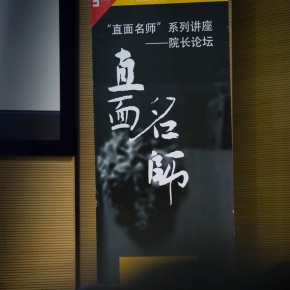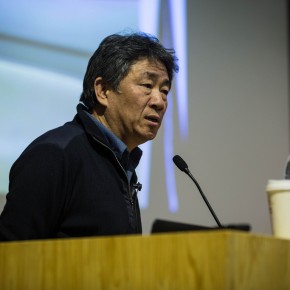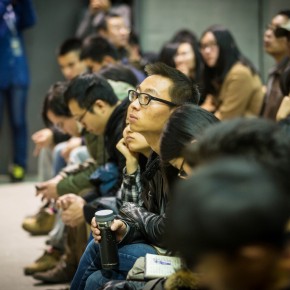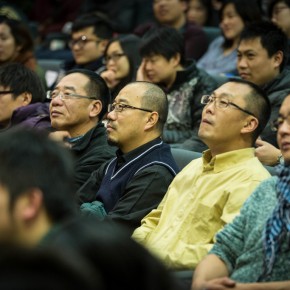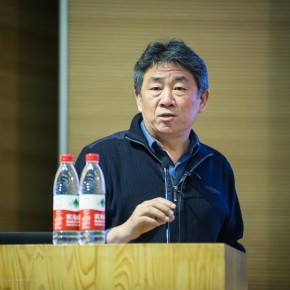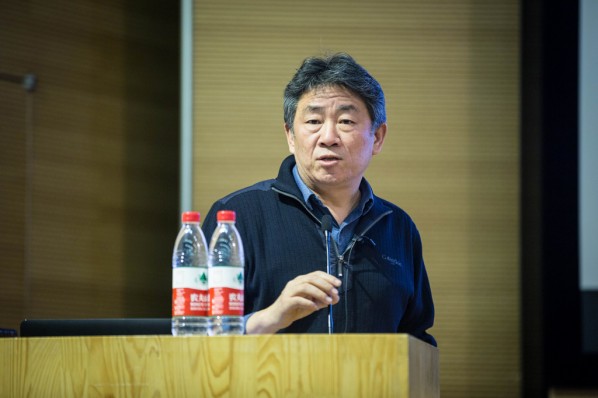
Organized by the Department of Study and Practice at the Student Union, the seventh session of “Facing Outstanding Teacher Series – Dean Forum” series lectures were held at the Auditorium in CAFA Art Museum at 18:30 on December 2, 2013, invited Prof. Tan Ping, Deputy Dean of CAFA, well-known artist to give a lecture. It started after the host briefly introduced Tan Ping.
Tan Ping’s lecture unfolded around his works, he explained his works while interpreted his creative methods and artistic ideas. Tan Ping majored in etchings in CAFA, the technique of etching is very complex, and time is a crucial factor, the length of time will determine the effect of the work. An unexpected factor making a metal plate soak in the acid longer than the expected time, resulted in the eventual effect that was different from the expected one. The ends of the screen were corroded, and the image was different from the original draft. But the accidental result greatly inspired him, so he had a great change in creative ideas, beginning to focus on the edges instead of objects on the screen, due to the edges becoming crucial when a work was put into a large space. So he gave up focusing on figurative painting and paid attention to abstract painting and began to explore the uncontrollability of the screen.
Tan Ping went to study in the Universitaet der Künste Berlin in 1989. He had learned two things in the five-year study: firstly focus on basic courses, secondly put the concept of time into the creation. His graduation works “Time” chronologically showcases the effects of a corroded coin of every half an hour, clearly showing the energy of time. And he introduced his works “Nuclear Radiation” which he created according to Fukushima nuclear radiation incident in Japan.
He showed his works of print “A LINE” in the National Art Museum of China in 2012, using of a round bladed knife to cut a 40-meter-long line. Because he was deeply influenced by Minimalism when studying in German, he strived to use the minimal forms to express the most content. In April 2013, he created “Covering”. It doesn’t focus on the finial effect of screen, while the creative process is the significance of the works. Tan recorded the whole process and showed it to the spectators through an image. He drew abstract graphics on a canvas (2 x 3 meters), applying pigments to cover the finished screen, which was finished in 20 minutes and then repeated it, it continued for 3 days. A lot of beautiful and finished screens were presented and they were covered at last. The artist wanted to express his artistic thought through the behavior: to break the traditional artistic ideas and forms, the artistic exploration was endless, while unpredictable creativity was often spawned out of the destruction.
Tan Ping is very keen with abstract art, and he believes that abstract art is a kind of expression to look inward, abstract images often containing a more profound meaning, better inspiring people to capture images, which is a better interaction with the spectators. His explorations are full of enthusiasm and expectation of the unknown, many people are confused by contemporary art, without a fixed criteria, but it is unnecessary to struggle with judging it is good or bad, the pros or cons, because historical choice is the answer. Live in the moment, all fearless and serious explorations are worthy of respect.
Q & A Section:
Would you like to introduce how to draw “Covering”, whether it is according to your own aesthetic experience it?
Tan Ping: I am not afraid to fail during the creation, deliberately starting from failures and mistakes, and then gradually find the correct result. Thus my creation is an unconscious choice, rather than intentional. However, eventual result of the screen is judged by my aesthetic experiences.
Your abstract art has actually developed very maturely, would you like to get out of this mode to explore a new way for expression?Tan Ping: Once you truly enter into abstract art, it’s hardly going back. I have become accustomed to the expressing way to look inward, mountains are no longer mountains for me but an established way and idea of observation is the obstacle for me to choose a new creative approach.
Journalist: Zhang Gaoshan, Photo: Hu Zhiheng/CAFA ART INFO
Translated by Chen Peihua and edited by Sue/CAFA ART INFO


